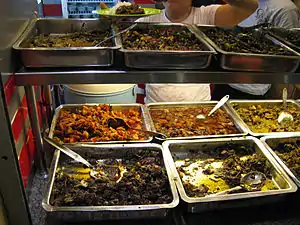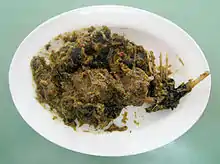Minahasan cuisine
Minahasan cuisine or Manado cuisine is the cooking tradition of the Minahasan people of North Sulawesi, Indonesia. It is popularly known as "Manadonese cuisine" after Manado, the capital of the province, although other cities in North Sulawesi, such as Bitung, Tomohon and Tondano, are also known as Minahasan culinary hotspots. Manadonese cuisine is known for its rich variations in seafood, generous amount of spices, extra-hot condiments,[1] exotic meats, and European-influenced cakes and pastries. Popular Manadonese dishes include tinutuan (Manado-style vegetable and rice congee), cakalang fufu (smoked skipjack tuna), cakalang noodle, paniki (spiced fruit bat), chicken or various fish and seafood spiced in rica-rica or woku spices, chicken tuturuga, and brenebon.

 |
| This article is part of the series on |
| Indonesian cuisine Masakan Indonesia |
|---|
|
|
Although not as popular and as widely distributed as Padang food and Sundanese cuisine, there is increasing awareness of Manadonese cuisine in the Indonesian cuisine scene. Numbers of Manadonese restaurants are growing in Indonesian cities such as Jakarta, Bandung, Medan, Surabaya and Makassar.
Traditions and influences
Manadonese cuisine is marked by a mixture of native and foreign influences. Native Minahasan cooking tradition relies heavily on seafood as well as exotic bushmeats, and its heavy use of freshly chopped hot spices. It also demonstrates Chinese and European influences (especially Portuguese and Dutch), most prominent in soups, cakes, and pastries.
Chicken and beef are commonly consumed. A significant number of Minahasans are Christians; the halal dietary law has thus not played an important role in the cuisine's development as it has for the Minahasans' Muslim neighbors on the Sulawesi island (the Gorontalos and Northern Maluku people). Pork, wild boar, and even dog meat and bat are hence more ubiquitous in Manadonese cuisine compared to other culinary traditions in the Indonesian archipelago.
Spices

Manadonese cuisine is well known for its generous use of spices, sometimes making up more than half of the whole dish's ingredients. It has given the cuisine the reputation of being hot and spicy, often from the freshly chopped chili peppers added in. Common spices used in Manadonese cuisine include lemongrass, lime or citrus leaves, lime juice, chili peppers, spring onion, shallots, garlic, clove and candlenut. Seafood, pork and chicken are often cooked in Manadonese signature bumbu (spice blends), such as rica-rica and woku. Spicy condiments are also served as dipping sauce for seafood, such as dabu-dabu and sambal roa.
Cakes and pastries

Among Indonesian ethnicities, Minahasans are well known for their affinities with European culture. A number of European-influenced cakes and pastries made their way into the Minahasan kitchen. The most notable probably is klappertaart (from Dutch language, lit. coconut tart). Another example is panada, a Portuguese-influenced pan (bread) similar to empanadas and filled with spiced ground skipjack tuna.
Seafood

Minahassa Peninsula – the northern arm of Sulawesi, a narrow peninsula that formed the North Sulawesi and Gorontalo provinces – are surrounded by seas in almost all sides. Minahasan people that inhabit the area have been harvesting the bounty of seas since a long time ago, therefore seafood is popular and almost become a staple diet. The Sulawesi Sea and Maluku Sea, and Gulf of Tomini are teeming with marine life. The harbor cities of Manado and Bitung are the center of fishing industry in the area. Actually, the whole eastern provinces of Indonesia, from Sulawesi to Maluku archipelago, are famous for their seafood. Various seafood such as cakalang (skipjack tuna), tude (mackerel), oci (larger mackerel), tuna, albacore, bobara (trevally), kakap (red snapper), kerapu (garoupa), tenggiri (wahoo), bawal (pomfret), shrimp, mussels and crabs are available in marketplace, and often being grilled on charcoal, and served in dabu-dabu condiment; cooked in woku or rica-rica spice, or in kuah asam soup.
Exotic meats
Minahasan people are also known for their bushmeats tradition. Before converting to Christianity in early 16th to 17th century, Minahasans were animists, and their practice on consuming almost every kind of animal still continued until this days. Rintek wuuk or RW (lit. Minahasan: "fine hair") is euphemism of dog meat. In Minahasan culture it is considered prestigious to consume rare and unusual meats. The marketplaces of the mountainous town of Tomohon and Tondano are notorious for selling various kinds of exotic bushmeats; from wild boar, field rats, patola snake (python), frog legs, paniki or fruit bats, and dog meat. Sometimes protected endangered animals such as yaki (Sulawesi black macaque), kuse (slow loris), tapir and anoa are illegally sold in marketplace as food.[2]
List of dishes
Dishes
- Cakalang fufu, cured and smoked skipjack tuna
- Dabu-dabu, a spicy condiment made of sliced tomato, chili pepper, shallot and lemon juice
- Kuah asam, lit. "sour soup" is soup of fish or seafood based soup
- Mie cakalang, skipjack tuna noodle soup, a Chinese-influenced dish
- Nasi kuning, turmeric rice, although similar recipe also known throughout Indonesia
- Paniki, spiced fruit bat
- Rica-rica, Pork, chicken or fish spiced in a lot of chili pepper
- Rintek wuuk (RW), lit. "fine hair", a euphemism for dog meat dish, served in plenty of spices
- Tinorangsak, spicy meat dish
- Tinutuan, sometimes called bubur manado or Midal (bubur manado with Noodle), Manado style vegetables and rice congee
- Woku, or its variant woku belanga; Pork, chicken or fish in woku spices
Vegetables

- Sayur bunga pepaya (papaya flower bud vegetables)
- Brenebon, red kidney bean soup, sometimes mixed with pig's trotters, beef or chicken
- Perkedel jagung (corn fritters)
- Rica rodo, stir fried and spiced young corn, string beans and eggplant
- Sayur daun papaya (papaya leaf vegetables)
- Sayur pakis (fern vegetables)
- Tumis kangkung (stir fried water spinach)
Snacks
- Es brenebon, sweet red kidney bean ice dessert
- Klappertaart
- Lalampa, similar to lemper
- Panada, similar to empanadas
- Perkedel nike (freshwater anchovy fritters)
- Pisang goroho, fried banana consumed with sambal roa (spicy condiment made from ground red chili pepper and smoked fish)
Gallery
 Bobara kuah asam, trevally in sour soup
Bobara kuah asam, trevally in sour soup Papaya flower bud cooked as vegetables
Papaya flower bud cooked as vegetables
References
- Pingkan Elita Dundu/Neli Triana (11 March 2013). "Selekta Rasa dalam Masakan Manado" (in Indonesian). Kompas.com. Retrieved 29 March 2014.
- Fitri Prawitasari (17 September 2013). "Mereka Terkaget-kaget di Pasar Tomohon..." (in Indonesian). Kompas.com. Retrieved 29 March 2014.
External links
 Media related to Cuisine of Manado at Wikimedia Commons
Media related to Cuisine of Manado at Wikimedia Commons
